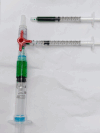A Dose-Image Optimization Trial for Voluven®-Assisted Indocyanine Green Fluorescence-Guided Breast Cancer Sentinel Lymph Node Surgery
- PMID: 40549082
- PMCID: PMC12317875
- DOI: 10.1245/s10434-025-17696-w
A Dose-Image Optimization Trial for Voluven®-Assisted Indocyanine Green Fluorescence-Guided Breast Cancer Sentinel Lymph Node Surgery
Abstract
Background: Sentinel lymph node biopsy (SLNB) is critical in breast cancer staging, and indocyanine green (ICG) has emerged as a promising fluorescent tracer. Optimizing ICG concentration with an appropriate solvent such as Voluven® could improve imaging quality and SLN detection, yet the ideal protocol remains undefined. This study investigates the optimal ICG:Voluven concentration for SLNB in breast cancer surgery.
Patients and methods: In a prospective trial (April 2022-June 2023), 12 women with early breast cancer underwent SLNB with ICG:Voluven at 0.5 mg/mL (5×, n = 3), 0.25 mg/mL (10×, n = 6), or 0.125 mg/mL (20×, n = 3). Outcomes included SLN retrieval, signal-to-background ratio (SBR), areola-to-axilla traveling time (AAT), safety, and cost, assessed via Stryker SPY Portable Handheld Imaging System.
Results: The 10× group (0.25 mg/mL) showed the highest median SBR (127.4, range 90.9-256.0) versus 5× (26.3, 2.7-133.2) and 20× (39.1, 5.3-98.4), retrieving three SLNs per patient consistently, unlike fewer in other groups. The 20× group had the shortest AAT (44.3 s) but lower SBR and procedural issues (e.g., subcutaneous dissection). The 5× group had the longest AAT (144.3 s) and reduced SLN detection. No adverse events occurred. The equivalent drug cost was around 1.5 US dollars per patient.
Conclusions: The 0.25 mg/mL ICG:Voluven concentration offers an optimal balance of fluorescence imaging quality, SLN detection, and procedural efficiency for SLNB in breast cancer surgery. Its safety, effectiveness, and low cost make it a practical choice, especially in resource-limited settings. Larger studies are needed to validate these results and refine the protocol further.
Keywords: 6% hydroxyethyl starch; Breast cancer; Dose optimization; Fluorescence-guided surgery; Indocyanine green; Sentinel lymph node biopsy.
© 2025. The Author(s).
Conflict of interest statement
Disclosure: Dr. Huang reports grants, personal fees, and nonfinancial support from Daiichi Sankyo; grants, personal fees, and nonfinancial support from Astra Zeneca; grants, personal fees, and nonfinancial support from EirGenix; grants, personal fees, and nonfinancial support from Eli Lilly; grants and nonfinancial support from MSD; grants from OBI Pharma; grants, personal fees, and nonfinancial support from Pfizer; grants, personal fees, and nonfinancial support from Roche; grants, personal fees, and nonfinancial support from Novartis; grants from Seagen; grants and personal fees from Gilead; and grants from Aston Sci outside the submitted work.
Figures




Similar articles
-
Sentinel lymph node detection by means of indocyanine green using the Karl Storz VITOM® fluorescence camera: a comparison between primary sentinel lymph node biopsy versus sentinel lymph node biopsy after neoadjuvant chemotherapy.J Cancer Res Clin Oncol. 2021 Jun;147(6):1813-1823. doi: 10.1007/s00432-020-03461-x. Epub 2020 Nov 23. J Cancer Res Clin Oncol. 2021. PMID: 33230583 Free PMC article.
-
Sentinel lymph node detection in early ovarian cancer: the role of indocyanine green as a single tracer.Int J Gynecol Cancer. 2025 Jun;35(6):101826. doi: 10.1016/j.ijgc.2025.101826. Epub 2025 Apr 17. Int J Gynecol Cancer. 2025. PMID: 40347521
-
The use of indocyanine green and technetium-99 for dual-tracer sentinel lymph node biopsy in breast cancer.Breast Cancer Res Treat. 2025 Aug;213(1):151-159. doi: 10.1007/s10549-025-07767-7. Epub 2025 Jun 27. Breast Cancer Res Treat. 2025. PMID: 40576864 Free PMC article.
-
Fluorescence indocyanine green (ICG) for sentinel-lymph-node mapping in colorectal cancer: a systematic review.Langenbecks Arch Surg. 2025 Jul 1;410(1):202. doi: 10.1007/s00423-025-03786-6. Langenbecks Arch Surg. 2025. PMID: 40590942 Free PMC article.
-
Indocyanine green and infrared fluorescence in detection of sentinel lymph nodes in endometrial and cervical cancer staging - a systematic review.Eur J Obstet Gynecol Reprod Biol. 2016 Nov;206:213-219. doi: 10.1016/j.ejogrb.2016.09.027. Epub 2016 Sep 30. Eur J Obstet Gynecol Reprod Biol. 2016. PMID: 27750179
References
-
- Pitsinis V, Kanitkar R, Vinci A, Choong WL, Benson J. Results of a prospective randomized multicenter study comparing indocyanine green (ICG) fluorescence combined with a standard tracer versus ICG alone for sentinel lymph node biopsy in early breast cancer: the INFLUENCE trial. Ann Surg Oncol. 2024;31(13):8848–55. 10.1245/s10434-024-16176-x. - PMC - PubMed
-
- Jinno H, Inokuchi M, Ito T, et al. The Japanese Breast Cancer Society clinical practice guideline for surgical treatment of breast cancer, 2015 edition. Breast Cancer. 2016;23(3):367–77. 10.1007/s12282-016-0671-x. - PubMed
-
- Cardoso F, Kyriakides S, Ohno S, et al. Early breast cancer: ESMO Clinical Practice Guidelines for diagnosis, treatment and follow-up†. Ann Oncol. 2019;30(8):1194–220. 10.1093/annonc/mdz173. - PubMed
MeSH terms
Substances
LinkOut - more resources
Full Text Sources
Medical
Research Materials
Miscellaneous

